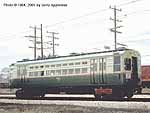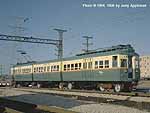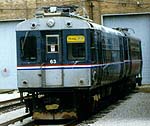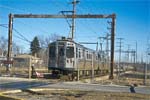The primary focus of my efforts has been modeling equipment from the Skokie Swift. This project actually predates any conception of building a layout (or even doing anything in O scale) by several years. The idea first came to me while riding home from Columbia College on the Red Line in 2005.
Growing up in Southwestern Evanston I was always aware of the Skokie Swift. I did not ride the line much, though a trip with my father shortly after the arrival of the 3200-series in the early 1990s did have a lasting impact. Still, the Skokie Swift was always present, acting at the very least as a distant portion of the soundtrack to a quiet evening. The line and it's unique catanary operation stayed with me through high school and on into college.
I started attending Columbia College Chicago in October 2004. Once I had gotten back into the swing of riding the "L" but before I had developed any real enthusiasm for it, I became vaguely aware that the "Yellow Line" (the Skokie Swift) no longer used the overhead wire and that the pantographs would be removed sometime in the near future. I felt that this passing should be commemorated in some small way (by me) and, on a whim one spring day, drew a crude rendering of a pair of Skokie-equipped 3200-series cars intended to be operated on LGB track.
This little project simmered in the back of my mind for a few years. Eventually I got into traction modeling in O scale. MTH released a series of O gauge (3-rail) 3200-series cars and eventually I acquired a few of these. By this time I had decided on moving forward with the Skokie concept (but in O scale) and, as I learned about the history of the operation, expanded the scope a bit.
The Skokie Swift Project
In my expanded version of the project, I have decided to model four different "sets" of equipment used on the Swift: a 1-50 series, a 5000-series, a "60" pair, and, of course, a 3200-series pair.
1-50 series
Experimental high-speed cars 1-4 were the first equipment rebuilt and assigned to the Skokie Swift.
Several years ago the Dunsel Line acquired an unused CTA 1-50 series car from the Chicago & Utopia Ry (Ed Halstead of Modeling Insull's Empire). This car will have its roof boards removed and replaced and will be equipped with CTA-designed trolley pans.

This car was previously owned by the late Dave of Dave's Rail Pix who equipped with car with CA&E trolley beams and sleet scrapers.
5000-series (as 51-54)
The second unit to be modeled is one of the most unique cars ever acquired by the rapid transit lines: the experimental 3-part articulated 5000-series cars. Like the 1-50, this car will also be equipped with trolley-pans. These four cars wandered the "L" system, not finding a permanent assignment due to some of the drawbacks of their design. They finally found a home on the Skokie Swift where their single unit, high capacity nature made them extremely useful. Once assigned, these cars remained in Skokie service for two decades before being retired.
61-65 series
The next set represented the first instance of a pair of cars being assigned to the line. In reality, the 60s were little more than pairs of rebuilt 5-50s that had been semi-permanently coupled and equipped with single-arm pantographs. I have yet to acquire a two more 1-50s, but I'm always looking.
3200-series
The 3200-series represents the last set of Skokie Equipment. These cars came equipped with pantographs for operation on the Swift.
For this, I'll be extensively rebuilding a pair of MTH 3200-series cars. The only downside here is that while the cars operate on O gauge track, they aren't O scale. MTH did a pretty good (not great, but far from terrible) job with the detail put into the cars, but unfortunately they didn't scale them properly for 1:48. Instead of being 12 inches long, the cars are 12 3/4 inches long from anticlimber to anciclimber. This is, however, fortunate as the cars are then the proper length for 17/64 (Q) scale, or approximately 1:45. This means they're correct for the track gauge.
In addition to the addition of roof boards and pantographs, these cars will have to be entirely rebuilt from the floor down and be outfitted with new interiors.
Lots to do!





No comments:
Post a Comment